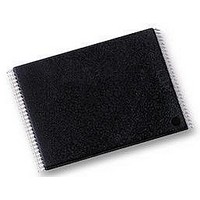AM29F400BT-55EF Spansion Inc., AM29F400BT-55EF Datasheet - Page 20

AM29F400BT-55EF
Manufacturer Part Number
AM29F400BT-55EF
Description
IC, FLASH, 4MBIT, 55NS, TSOP-48
Manufacturer
Spansion Inc.
Datasheet
1.AM29F400BB-70EF.pdf
(43 pages)
Specifications of AM29F400BT-55EF
Memory Type
Flash
Memory Size
4Mbit
Memory Configuration
512K X 8 / 256K X 16
Access Time
55ns
Supply Voltage Range
4.75V To 5.25V
Memory Case Style
TSOP
No. Of Pins
48
Cell Type
NOR
Density
4Mb
Access Time (max)
55ns
Interface Type
Parallel
Boot Type
Top
Address Bus
19/18Bit
Operating Supply Voltage (typ)
5V
Operating Temp Range
-40C to 85C
Package Type
TSOP
Program/erase Volt (typ)
4.75 to 5.25V
Sync/async
Asynchronous
Operating Temperature Classification
Industrial
Operating Supply Voltage (min)
4.5V
Operating Supply Voltage (max)
5.5V
Word Size
8/16Bit
Number Of Words
512K/256K
Supply Current
50mA
Mounting
Surface Mount
Pin Count
48
Lead Free Status / Rohs Status
Compliant
WRITE OPERATION STATUS
The device provides several bits to determine the
status of a write operation: DQ2, DQ3, DQ5, DQ6,
DQ7, and RY/BY#. Table 6 and the following subsec-
tions describe the functions of these bits. DQ7, RY/
BY#, and DQ6 each offer a method for determining
whether a program or erase operation is complete or in
progress. These three bits are discussed first.
DQ7: Data# Polling
The Data# Polling bit, DQ7, indicates to the host
system whether an Embedded Algorithm is in progress
or completed, or whether the device is in Erase Sus-
pend. Data# Polling is valid after the rising edge of the
final WE# pulse in the program or erase command
sequence.
During the Embedded Program algorithm, the device
outputs on DQ7 the complement of the datum pro-
grammed to DQ7. This DQ7 status also applies to
programming during Erase Suspend. When the
Embedded Program algorithm is complete, the device
outputs the datum programmed to DQ7. The system
must provide the program address to read valid status
information on DQ7. If a program address falls within a
protected sector, Data# Polling on DQ7 is active for
approximately 2 µs, then the device returns to reading
array data.
During the Embedded Erase algorithm, Data# Polling
produces a “0” on DQ7. When the Embedded Erase
algorithm is complete, or if the device enters the Erase
Suspend mode, Data# Polling produces a “1” on DQ7.
This is analogous to the complement/true datum output
described for the Embedded Program algorithm: the
erase function changes all the bits in a sector to “1”;
prior to this, the device outputs the “complement,” or
“0.” The system must provide an address within any of
the sectors selected for erasure to read valid status
information on DQ7.
After an erase command sequence is written, if all
sectors selected for erasing are protected, Data#
Polling on DQ7 is active for approximately 100 µs, then
the device returns to reading array data. If not all
selected sectors are protected, the Embedded Erase
algorithm erases the unprotected sectors, and ignores
the selected sectors that are protected.
When the system detects DQ7 has changed from the
complement to true data, it can read valid data at
DQ7–DQ0 on the following read cycles. This is
because DQ7 may change asynchronously with
DQ0–DQ6 while Output Enable (OE#) is asserted low.
Figure 15, Data# Polling Timings (During Embedded
Algorithms), in the “AC Characteristics” section illus-
trates this.
18
D A T A
Am29F400B
S H E E T
Table 6 shows the outputs for Data# Polling on DQ7.
Figure 4 shows the Data# Polling algorithm.
Notes:
1. VA = Valid address for programming. During a sector
2. DQ7 should be rechecked even if DQ5 = “1” because
No
erase operation, a valid address is an address within any
sector selected for erasure. During chip erase, a valid
address is any non-protected sector address.
DQ7 may change simultaneously with DQ5.
Figure 4. Data# Polling Algorithm
Read DQ7–DQ0
Read DQ7–DQ0
DQ7 = Data?
DQ7 = Data?
Addr = VA
Addr = VA
DQ5 = 1?
START
FAIL
No
Yes
No
21505E8 November 11, 2009
Yes
Yes
PASS















